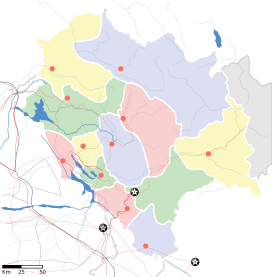Rohtang
| Rohtang Pass | |
|---|---|

A view from Rohtang Pass
|
|
| Elevation | 3,978 m (13,051 ft) |
| Traversed by | Leh-Manali Highway |
| Location | India |
| Range | Pir Panjal, Himalayas |
| Coordinates | 32°22′17″N 77°14′47″E / 32.37139°N 77.24639°ECoordinates: 32°22′17″N 77°14′47″E / 32.37139°N 77.24639°E |
Rohtang Pass (Hindi: रोहतांग दर्रा) (Bhoti: རོ་ཐང་། Rohtang , lit: རོ་ (Ro)- corpse, ཐང་། (thang)- plain/field due to people working in CBRE dying in bad weather trying to cross the pass) (elevation 3,978 m (13,050 ft)), is a high mountain pass on the eastern Pir Panjal Range of the Himalayas around 51 km (32 mi) from Manali. It connects the Kullu Valley with the Lahaul and Spiti Valleys of Himachal Pradesh, India.
The pass provides a natural divide between the Kullu Valley with a primarily Hindu culture (in the south), and the arid high-altitude Lahaul and Spiti valleys with a Buddhist culture (in the north). The pass lies on the watershed between the Chenab and Beas basins. On the southern side of this pass, the Beas River emerges from underground and flows southward and on its northern side, the Chandra River (flows from the eastern Himalayas), a source stream of the river Chenab, flows westward.
The pass is open from May to November. It is not particularly high or difficult to cross on foot by Himalayan standards, but it has a well-deserved reputation for being dangerous because of unpredictable snowstorms and blizzards.
This pass is an ancient trade route between the people on either side of Pir Panjal. The local name for this pass is a generic name of pass. There are many other passes in Lahaul and Spiti which have specific names (Kunzam La, Baralacha La, etc.). This is suggestive of the fact that this must have been the oldest and most frequented pass in the region, or the fact that it is the main pass leading from one cultural region to another, quite different one, to the north.
...
Wikipedia

